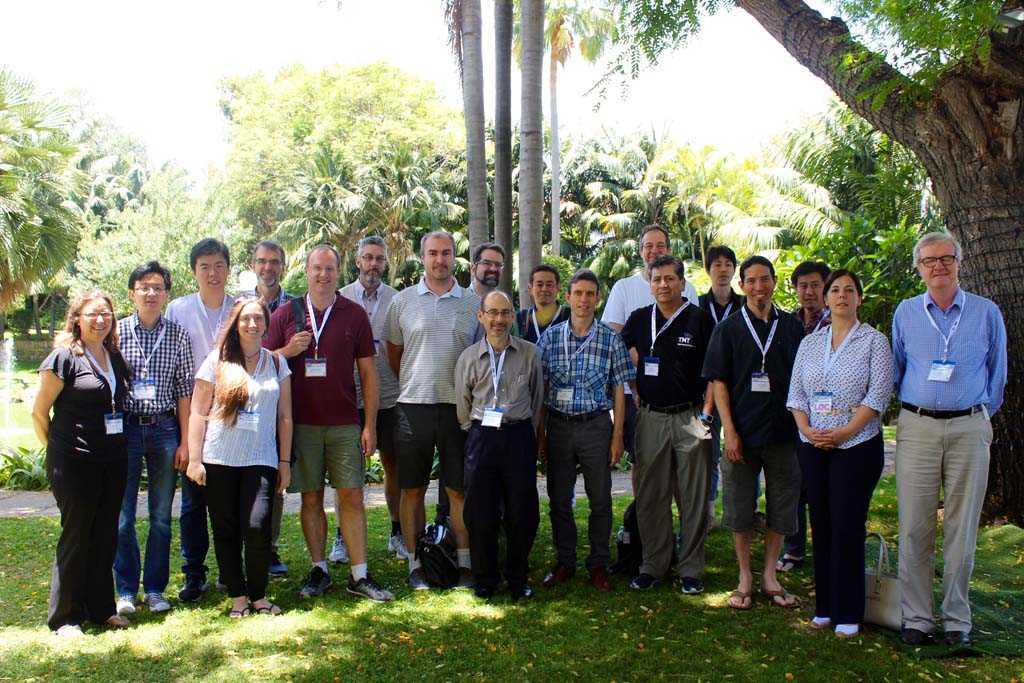
Scientists and engineers from around the world representing TMT project at the AO4ELT5 meeting that took place in Puerto de la Cruz, in the Canary island of Tenerife, Spain.


Scientists and engineers from around the world representing TMT project at the AO4ELT5 meeting that took place in Puerto de la Cruz, in the Canary island of Tenerife, Spain.
The fifth edition of the Adaptive Optics for Extremely Large Telescope meeting (AO4ELT) was recently held in Puerto de la Cruz, in the Canary island of Tenerife, Spain. The conference gathered specialists from all around the world to discuss the latest developments made in Adaptive Optics for the current and next-generation of ground-based telescopes.
More than 20 scientists working for, or contributing to, the TMT projects traveled to Puerto Cruz to attend this week-long conference organized by the Instituto de Astrofísica de Canarias (IAC).
Gary Sanders, the TMT Project Manager, opened the conference with a tribute in memory of Jerry Nelson, a pioneer in developing the segmented primary mirror concept used for today’s telescopes of the 10m class, and that will be a key-component of the TMT. Nelson also invented the innovative techniques of stressed mirror polishing. He will be sorely missed by the TMT and adaptive optics communities.
Corinne Boyer, TMT Adaptive Optics Group Leader, was the first keynote speaker. She provided an overview of the progress made in the design and development of key components for TMT’s AO systems at the TMT project office and throughout its partner institutions: the National Research Council, Herzberg, in Victoria Canada and the Institute of Optics and Electronics in Chengdu (China).
TMT’s AO facility consists of the Narrow Field InfraRed AO System (NFIRAOS), its associated Laser Guide Star Facility (LGSF) and the AO Executive Software (AOESW).
NFIRAOS is a multi-conjugate AO (MCAO) Laser Guide Star (LGS) system, capable of feeding a corrected wavefront to three instruments. The AO system will have two deformable mirrors conjugated at the altitudes of the ground and 11.8km, with the DM conjugated to the ground mounted on a tip/tilt stage to reduce the number of optical surfaces. The system will also have six high order laser guide star wavefront sensors and one high order natural guide star (NGS) wavefront sensor for truth wavefront sensor or operation without laser. To provide an optimal correction of atmospheric turbulences, windshake, optical errors and plate scale distortion, NFIRAOS will also use up to three additional low-order (tip/tilt and/or focus) IR wavefront sensors within the science instruments (OIWFS), and up to four guide windows on the science detectors.
TMT is working with two DM vendors to design and prototype the NFIRAOS DMs and with the Lincoln Laboratory of the Massachusetts Institute of Technology and Astronomical Research Cameras, Inc. (ARC) to develop detectors and Shack-Hartmann wavefront sensor visible cameras optimized for LGS and high order NGS systems. NFIRAOS will use seven of these cameras in its multi-conjugate AO system.
The LGSF will generate the artificial laser guide stars required by NFIRAOS and will be capable of projecting different asterism geometries, depending on the needs of the science programs. Up to nine sodium lasers (six at first-light) will be located on a platform behind the TMT’s elevation journal, below the primary mirror. The beams will then be transported to a location behind the TMT’s secondary mirror, where the asterisms will be generated prior to their projection on-sky through a laser launch telescope.
The AOESW includes several sub-systems dedicated to efficiently and safely coordinating and synchronizing the operations of the AO systems and wavefront sensing sub-systems of NFIRAOS, initializing and optimizing the parameters of the NFIRAOS Real Time Controller and estimating the AO-corrected Point Spread Function (PSF) for the science observations. TMT scientists also reported on the comprehensive and detailed AO modeling needed to support the design and development of the first-light TMT AO facility, as well as on recent studies carried out to investigate the performance improvement obtained with an Adaptive Secondary Mirror. Additional reports on AO systems budgets and requirements were provided at the conference by members of the TMT systems engineering team.
Conference participants enjoyed special tours throughout the week, including a visit of the Observatorio del Teide, based in Tenerife. Teide Obs. was the first professional observatory installed on the island. It began operations in 1964 and is the location of the world’s second largest solar telescope.
Another tour was held at Roque de los Muchachos Observatory (ORM) on La Palma, the most northwesterly island of the Canary Islands. The observatory site is part of the European Northern Observatory and is operated by the Instituto de Astrofísica de Canarias. The site offers the most extensive astronomical facilities located in the Northern Hemisphere. Among several others, its fleet of telescopes includes the 10.4 m Gran Telescopio Canarias, the world's largest single-aperture optical telescope, the William Herschel Telescope (second largest in Europe), and the adaptive optics corrected Swedish 1-m Solar Telescope, which provides the highest resolution solar imaging.
In March 2017, TMT International Observatory (TIO) and IAC signed a hosting agreement. While Maunakea in Hawaii continues to be the preferred choice for the location of the TMT, the Observatorio del Roque de los Muchachos has become TMT’s alternative site. ORM benefits from excellent conditions for adaptive optics observations and will enable breakthrough transformative science should the Thirty Meter Telescope need to move there.
ThoughtWorks Team Gathers at TMT Project Office for Second Inception Meeting
Twenty-Nine Students Named To Akamai Summer Internship Program